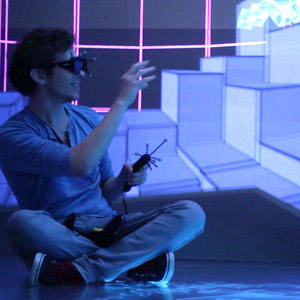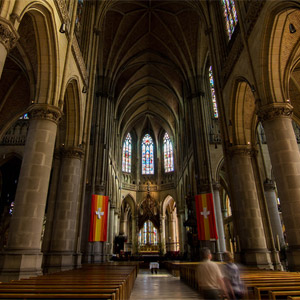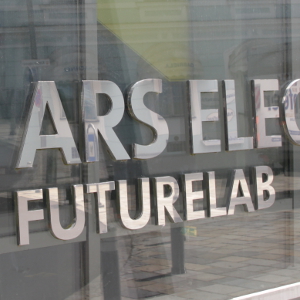The CyberArts Exhibition is traditionally one of the centerpieces of the Ars Electronica Festival. It showcases a selection of works singled out for recognition by the 2014 Prix Ars Electronica’s Interactive Art, Digital Communities and Computer Animation categories as well as [the next idea] voestalpine Art and Technology Grant. Roy Ascott, the first Visionary Pioneer of Media Art, will make a live appearance.
A new exhibition entitled Device Art will premiere in the Ars Electronica Center. It features works by 14 artists from Japan, USA and Europe, each project a blend of high-tech and elements of traditional Japanese culture.
The main building of Linz Art University will host the annual Campus Exhibition curated this year by ART2 of Mons, Belgium. In the so-called spaceship on the other side of the Main Square, students in Linz’s Interface Cultures program will display their prodigious talents.
The stars of the Featured Artists exhibition are a duo named Shinseungback Kimyonghun consisting of South Korean artists Shin Seung Back and Kim Yong Hun. They’ll present 10 works that explore the social and cultural impact of computational imaging and vision.
St. Mary’s Cathedral, better known here as Mariendom, will be a prominent venue and, for the first time, exhibition space—for instance, for interactive installations including Archifon II, Netykavka and Mirage.
The CyberArts exhibition is a centerpiece of the Ars Electronica Festival. It showcases works honored by the Prix Ars Electronica in 2014.
Device art is a relatively young art form. A group centered on Hiroo Iwata (JP) at the University of Tsukuba initiated the device art movement in 2004. The point is to use innovative materials and techniques to create high-tech appliances featuring sophisticated, cool design. They thus combine art, design, technology, science and entertainment. The content of device art is the device itself.
An exhibition at the Akademisches Gymnasium is dedicated to the works and projects of the Future Innovators Summit.
The featured artists at the 2014 Ars Electronica Festival are a duo from the Republic of Korea. Since 2012, computer specialist Shin Seung Back and artist Kim Yong Hun have been working together under the dual portmanteau Shinseungback Kimyonghun. 10 works representative of their oeuvre are on display at Ars Electronica.
ARTS² is an art academy in the city of Mons, Belgium, the 2015 European Capital of Culture. The school provides training in the visual arts, music and theater. Its multidisciplinary structure makes it the ideal place for collaborative projects by students in different majors.
It’s been 10 years since Christa Sommerer (AT) and Laurent Mignonneau (FR) established the Interface Cultures program at Linz Art University. Interactive art and innovative interface design at the nexus of art, design and research are the core elements of this course of study in theory and practice.
Contemporary life is full of rapid changes, the virtual collides with reality, chaos is the ultimate master. In the current digital era, we are overloaded with information yet lack the wisdom to process it. We know everything, yet are still lost.
For two years now, the Mariendom is the scene of acoustic installations and performances that will be presented during the festival: It was Sam Auinger in 2012 and Rupert Huber in 2013 who brought the dome to sound. This year the Diocese of Linz and the Ars Electronica go one step further and transform the Mariendom to an unique exhibition scene throughout the festival. A number of artistic installations can be experienced in the nave, the crypt and Rudiger hall.
Taking an artistically playful approach to the here & now is the passionate pursuit of Japanese performance art collective Grinder-Man. Their eight-minute-long experience entitled “Mirage” is dedicated to an age-old yearning: the blurring of the past and future and thus the dissolution of the reality to which we’re accustomed.
When it gets dark in the evening, the large square in front of the Mariendom turns into a stage for luminous interactive media art projects.
Questioning everything we perceive, the art project Infinite Screen is focused on the illusionary surface of images, researching the light impulse inside the hidden alphabet of invisible red, blue and green light pixels which make up all surrounding digital information, virtual image and text.
Future Playground is a showcase of notable new developments by the Ars Electronica Futurelab and Ars Electronica Solutions. Visitors are invited use this perusal of what’s happening at the nexus of art, technology and society as an opportunity to give some thought to this year’s festival theme, change, at an interesting array of interactive exhibits, live performances, speeches and round-table discussions.
The Ars Electronica Futurelab has a long track record of working with artists and researchers in residence and is specialized on working on trans-disciplinary projects that are located at the nexus of art, technology and society, and has a worldwide network of collaborating partners.













